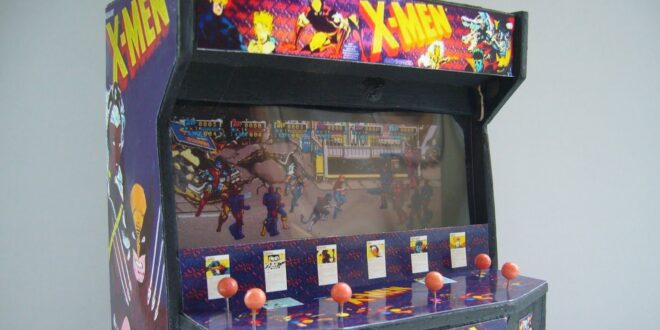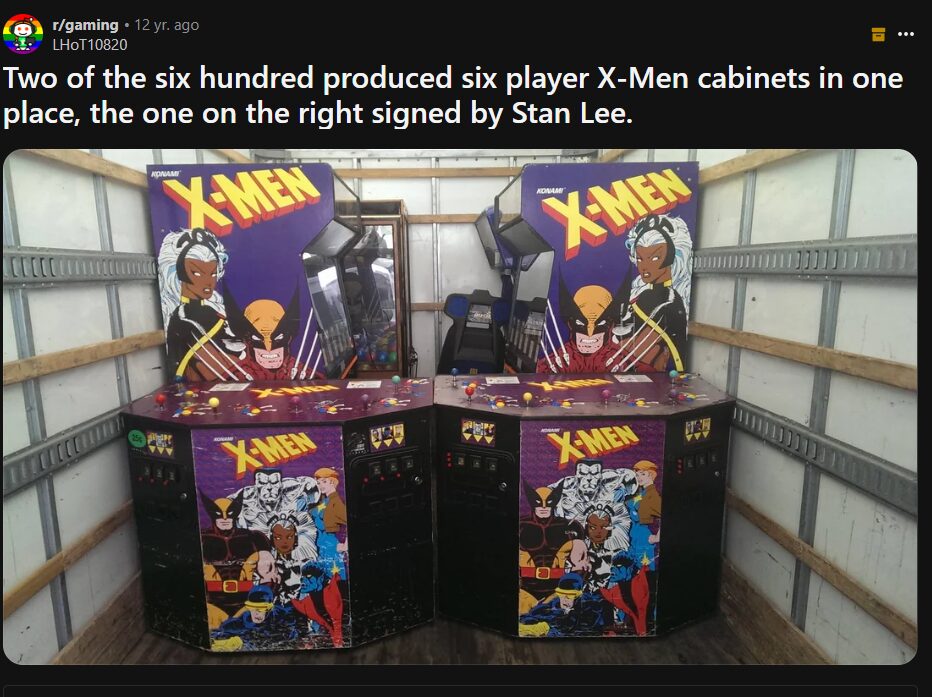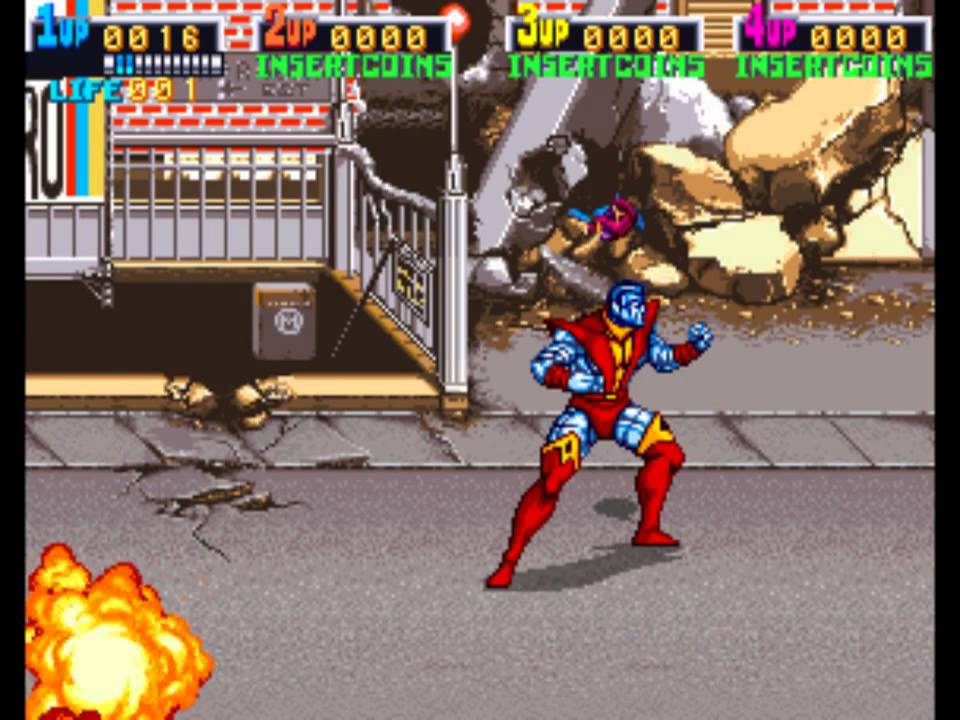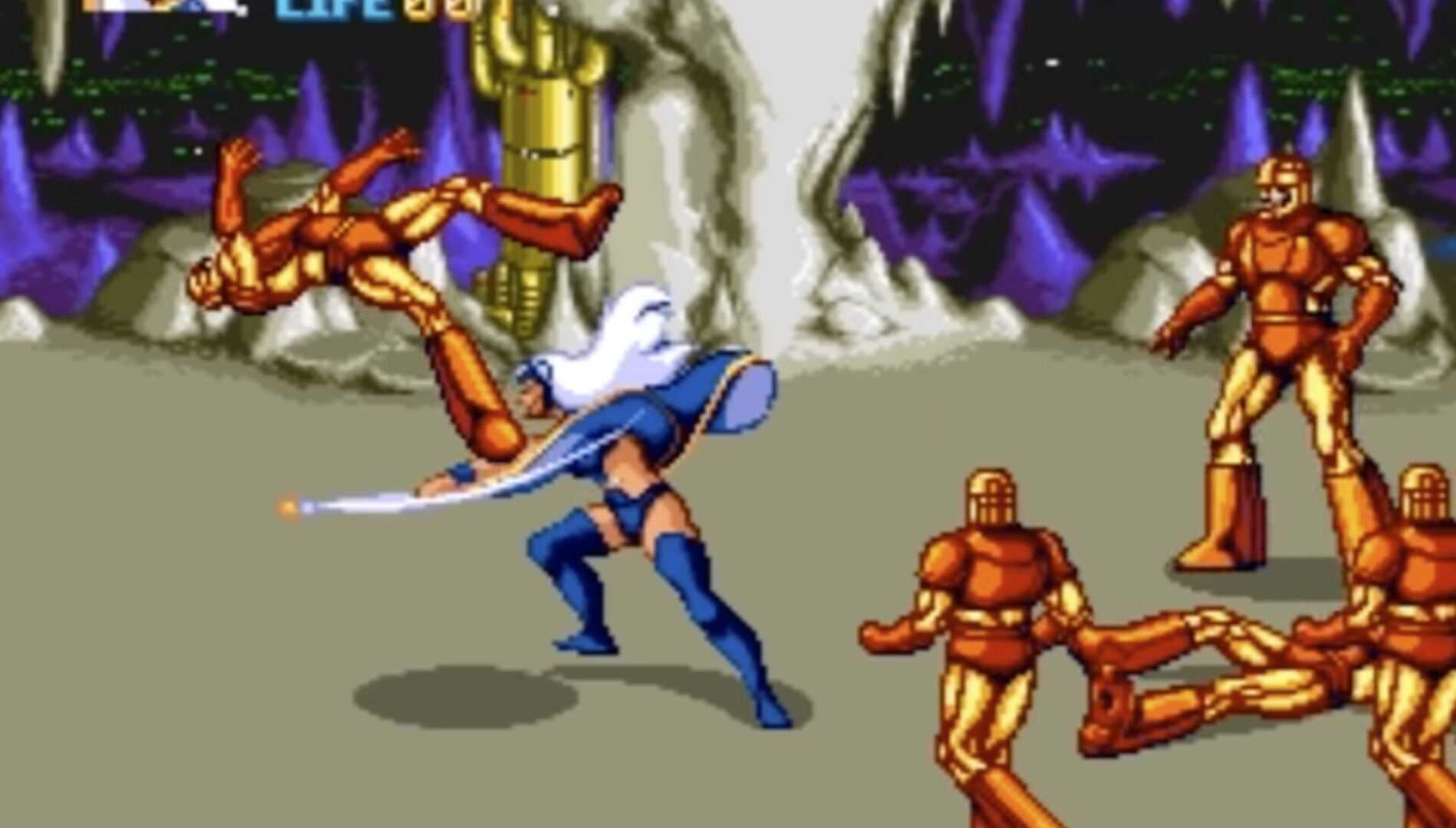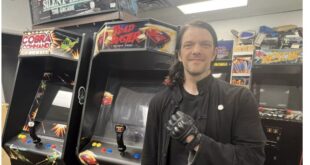A Marvel in Coin Op Form
There are certain machines that instantly capture the imagination of anyone who grew up in the neon glow of the arcade era. The six player X-Men arcade cabinet is one of them. Released by Konami in 1992, this massive, hulking creation became a legend for its sheer size, the chaotic fun of six simultaneous players, and the novelty of its dual screen setup. Unlike the more common two or four player versions that graced pizza parlors and bowling alleys across the country, the six player cabinet felt like an event every time you walked into a room and saw it.
(HEY YOU!! We hope you enjoy! We try not to run ads. So basically, this is a very expensive hobby running this site. Please consider joining us for updates, forums, and more. Network w/ us to make some cash or friends while retro gaming, and you can win some free retro games for posting. Okay, carry on 👍)
Part of what makes this cabinet so fascinating is its rarity. According to collectors and operators, only somewhere between 400 and 600 of these deluxe cabinets were ever produced, making it one of the rarer mainstream arcade releases of its era. While that figure has never been officially confirmed by Konami, it has become accepted lore within the arcade preservation community. And when you think about the logistics of producing and shipping something this enormous, the limited production numbers make a lot of sense.
But rarity alone does not tell the whole story. This is a machine that represented the peak of a certain era, the last great wave of arcade dominance before home consoles began to take over. It was bold, it was innovative, and it was loud both in sound and in presence. Today it is remembered not just as a cabinet, but as a cultural moment, cemented in the memories of those who grew up feeding quarters into its six control panels.
Historical Context: Konami, Arcades, and the Early Nineties
By the early 1990s the arcade industry was in a transitional phase. The boom years of the early 1980s had cooled after the 1983 video game crash, but the industry reinvented itself with fighting games, licensed properties, and cooperative beat em ups. Konami in particular had carved out a niche as the king of the latter. From Teenage Mutant Ninja Turtles to The Simpsons, the company’s side scrolling multiplayer games became fixtures in arcades everywhere.
The release of X-Men in 1992 was both a continuation of this trend and a bold escalation. Licensing Marvel’s mutants was a savvy move: the comic book franchise was hitting new heights of popularity in the early 1990s, and the arcade cabinet even drew inspiration from the 1989 animated pilot Pryde of the X-Men. With its recognizable characters, easy to grasp gameplay, and cooperative chaos, it was tailor made for arcade crowds. (We gobble anything X-Men related up around here.)
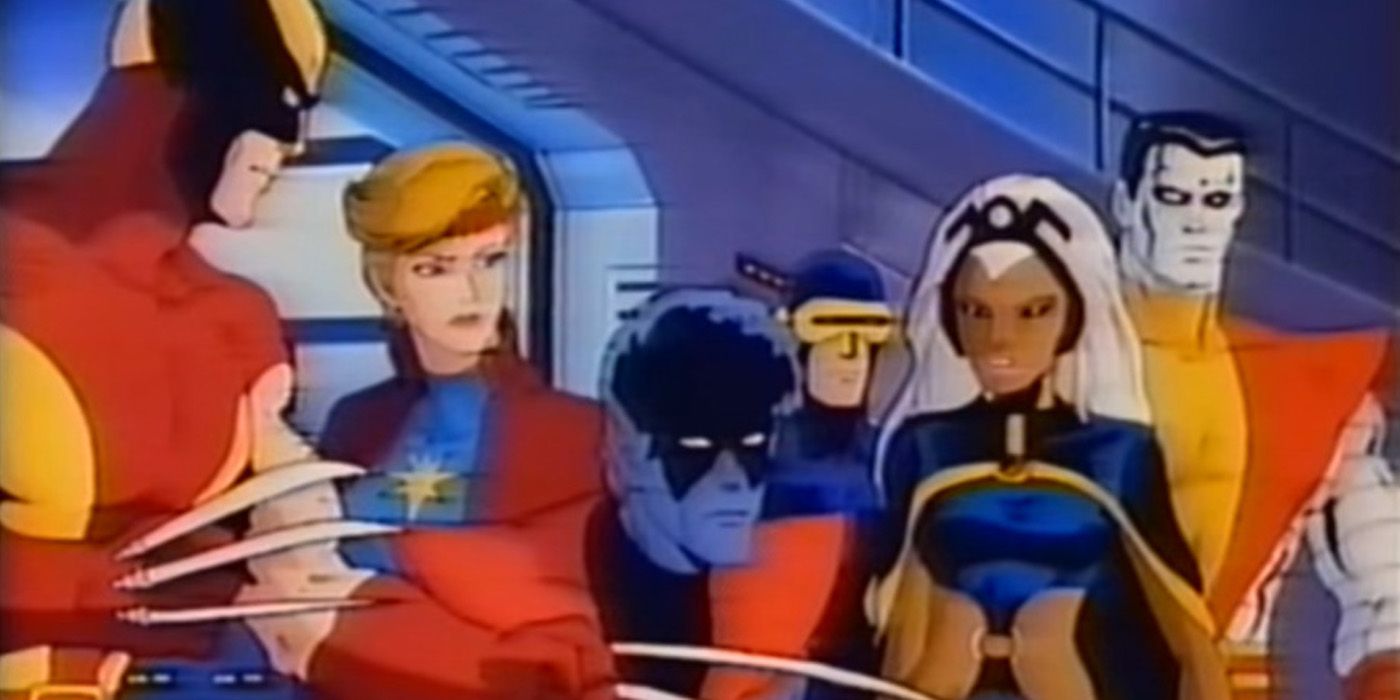
Arcade operators at the time were looking for ways to stand out. A two player or even a four player cabinet could be a hit, but imagine walking into an arcade and seeing six players crowded shoulder to shoulder, teaming up as Cyclops, Wolverine, Storm, Colossus, Nightcrawler, and Dazzler to fight Magneto’s forces. It was not just a game, it was a spectacle. And that spectacle was exactly what Konami was aiming for.
Hardware Deep Dive: Double Screens and a Mountain of Wood
The six player X-Men cabinet was not just bigger than its contemporaries, it was unlike anything else in arcades. Its most striking feature was its dual screen setup, a clever piece of engineering that stitched together two CRT displays into one massive playfield. To achieve this effect, one screen was mounted upright while the other was positioned horizontally inside the cabinet, its image reflected upward through a mirror. To players, it looked seamless, as if they were looking at a single ultra wide screen.
 The cabinet itself was huge, described by owners as measuring around four feet wide and six feet deep, and tipping the scales at several hundred pounds. Because of its immense size, the machine was designed to break down into three main components: the control panel pedestal, the monitor housing, and the rear cabinet. This made it at least somewhat possible to transport, but even in pieces it was one of the most intimidating arcade machines to move. Collectors often note that moving one up or down stairs is practically a nightmare (YouTube restoration video).
The cabinet itself was huge, described by owners as measuring around four feet wide and six feet deep, and tipping the scales at several hundred pounds. Because of its immense size, the machine was designed to break down into three main components: the control panel pedestal, the monitor housing, and the rear cabinet. This made it at least somewhat possible to transport, but even in pieces it was one of the most intimidating arcade machines to move. Collectors often note that moving one up or down stairs is practically a nightmare (YouTube restoration video).
On the control panel, six sets of joysticks and buttons lined up side by side. Each player could choose from one of the six playable heroes, and each character had their own unique moves and powers. With all six slots filled, the cabinet came alive with a cacophony of button presses, character voices, and Konami’s signature sound design. It was chaos, but the kind of chaos that defined the arcade experience.
Production Mystery: How Many Were Really Made?
Here is where things get interesting. Ask any collector or operator how many six player X-Men cabinets were made, and you will almost always hear the same range: between 400 and 600 units. That number has been repeated in Reddit threads, arcade forums, and collector circles for years. But as with many pieces of arcade history, there is no official Konami document confirming it.
Some enthusiasts point out that the figure fits the industry norms of the time. By the early 1990s arcade manufacturers had learned to be cautious. Gone were the days of 10,000 plus production runs that might end up unsold in warehouses. Deluxe cabinets in particular were made in smaller numbers because of the sheer costs of materials and shipping. The six player X-Men was expensive to produce and difficult to move, so a limited run is plausible.
Still, the mystique of the number adds to the legend. Whether it was 400, 500, or 600, what is certain is that the six player cabinets were never mass marketed in the same way as their smaller cousins. They were meant for high traffic arcades that could justify the space, and that exclusivity is part of what makes them so treasured today.
Distribution Patterns: Why the Midwest Was Swimming in Them
One of the quirks of the six player X-Men cabinet is that they were not evenly distributed across the United States. Collectors and former arcade operators have noted that the Midwest had a disproportionate share of them. The reason was shipping logistics. The cabinets were reportedly produced by Konami’s U.S. division in Buffalo Grove, Illinois. Moving these enormous machines was no small feat, so many stayed close to where they were made (Reddit user testimony).
This meant that if you grew up in places like Chicago, Milwaukee, or Indianapolis, you probably saw the six player cabinet more often than kids in California or Florida. For some it felt like every arcade had one, while for others the machine was a rare unicorn spotted once in a major city arcade and never seen again.
This uneven distribution has had ripple effects in the collector market. Midwest operators who held onto their machines had easier access to them when arcades began closing in the 2000s. As a result, many of the cabinets that pop up for sale today are still in that region. It also means that for many collectors outside the Midwest, the six player X-Men was something they only ever read about until the internet connected arcade fans worldwide.
Gameplay Realities: Six Heroes, One Screen, and Absolute Chaos
At its core, X-Men was a straightforward side scrolling beat em up. Players moved left to right, battling waves of Sentinels, soldiers, and mutant villains. Each character had basic attacks and a special power move that drained health but dealt heavy damage. The gameplay was simple enough for anyone to pick up, but the fun came from the sheer number of people crammed into the cabinet (Wikipedia).
When all six spots were filled, it was glorious mayhem. Wolverine slashed through enemies while Colossus unleashed his iconic power up yell that rattled the speakers. Storm blasted foes with lightning while Nightcrawler teleported across the screen. The mirror assisted dual screens gave everyone plenty of space to see the action, but the real spectacle was the energy of six players working together, often shouting and laughing as they tried not to get overwhelmed.
The game was not without its quirks. With six players, it was easy to lose track of your character in the chaos. Friendly fire was not a thing, but crowding often made it difficult to land precise hits. And of course, operators loved it because the difficulty paired with the health draining special moves meant lots of quarters flowing in. But these imperfections are part of what gave the six player experience its unique flavor. It was overwhelming, chaotic, and unforgettable.
Commercial Success: A Top Grossing Cabinet
For all its size and cost, the six player X-Men cabinet turned out to be a smart investment for many operators. In 1992 it was listed as one of the top five highest grossing dedicated cabinets in the United States, proof that players were more than willing to crowd around and pump in quarters. The game even received a nomination from the Amusement and Music Operators Association for “most innovative new technology,” thanks in large part to its ambitious hardware design.
This recognition matters because it showed that Konami’s gamble paid off. They had built something impractical on paper, a massive dual screen machine that was hard to move and expensive to manufacture. But once it hit the arcade floor, it drew attention like nothing else. Six players meant six potential customers at once, and the spectacle alone drew in curious onlookers who often joined the next round.
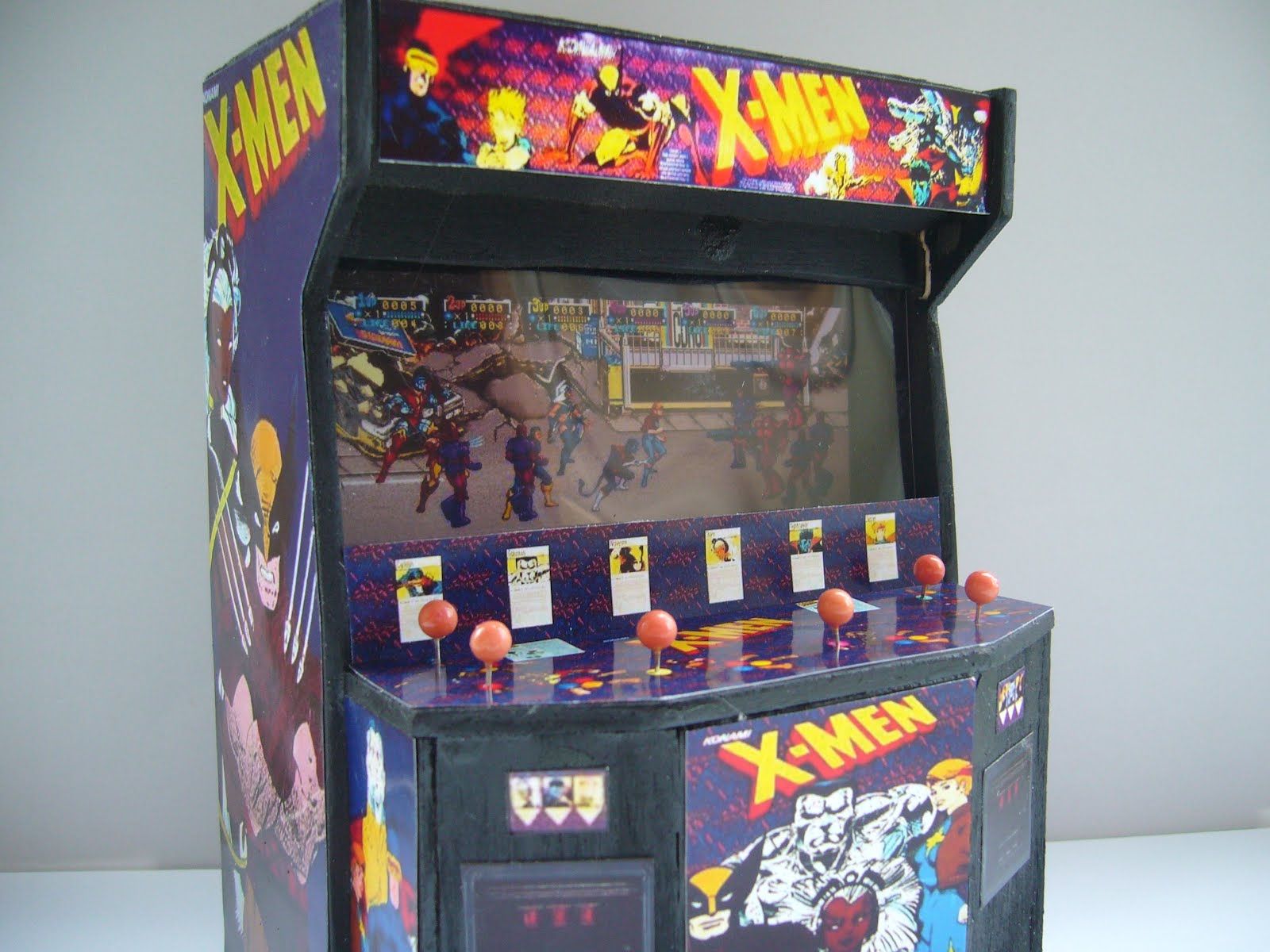
While not every arcade could afford the space or cost, those that did often found the six player X-Men to be a centerpiece. It was not just another machine tucked into a corner. It was a headline attraction, often placed front and center to show off the arcade’s big guns.
Collector Landscape: The Market Today
Fast forward three decades, and the six player X-Men cabinet has become one of the most coveted pieces in the arcade collecting scene. Restored units have sold for between 4,000 and 5,000 dollars depending on condition (arcade museum sales thread). One seller in Houston noted replacing everything from the power supply to the amplifier board in recent years to keep their machine in working order (for sale listing). Now sold.
But here is the catch: owning one is not easy. Collectors repeatedly warn about the challenges of moving and housing these beasts. They do not fit through standard doors without disassembly, they weigh a ton, and they take up a massive footprint in any room. For many it is not about practicality, it is about passion. Having one of the 400 to 600 cabinets ever made is a badge of honor, even if it means sacrificing half your garage.
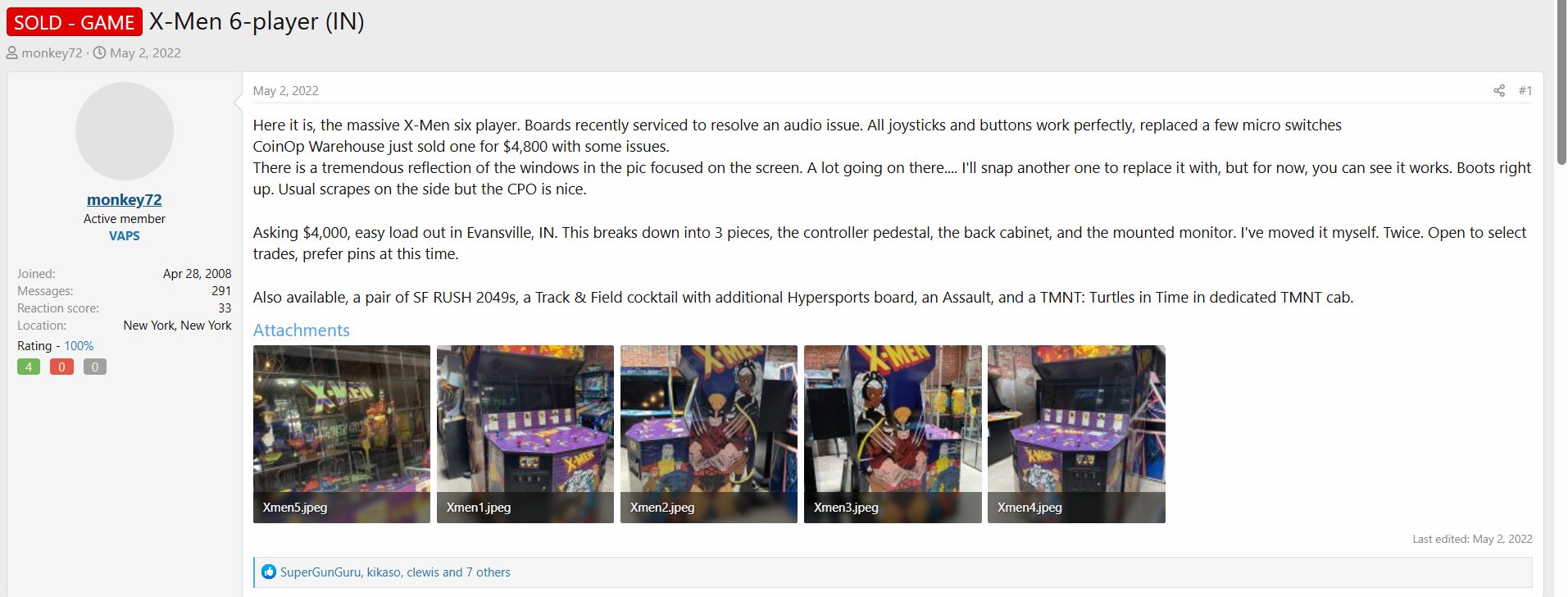
Online, these machines occasionally pop up in collector forums, especially in the Midwest. The rarity of listings has only added to their mystique. For every person who dreams of owning one, there is someone else who owned one and sold it, citing space issues. In that way, the six player X-Men continues to test the dedication of even the most diehard collectors.
Personal Narratives: Memories from the Arcade Floor
Beyond numbers and collector prices, what makes the six player X-Men so legendary are the stories. On Reddit, one user recalled growing up in a town of less than 50,000 people that somehow had four arcades, and every single one had the six player X-Men. For others, it was the holy grail, a machine they only ever saw once on a family trip and never forgot.
Collectors often reminisce about the sheer absurdity of playing shoulder to shoulder with five other kids, each frantically hammering buttons as the screen filled with chaos. Some remember local legends who could clear the game on a single credit, while others remember marathon sessions where groups of friends pooled their allowances just to reach Magneto.
These personal anecdotes are what transform the six player X-Men from an interesting piece of hardware into something more profound. It is a machine tied to childhood memories, to friendships, to the communal energy of the arcade. In an era where gaming has become more solitary or online, it represents a time when six people had to physically stand together, fight together, and celebrate victories together.
Why Any of This Matters
The six player X-Men arcade cabinet was never just another quarter munching machine. It was a spectacle, a piece of living theater that stood at the crossroads of comic book fantasy and the golden age of the arcade. From the moment it appeared on the floor it carried a sense of grandeur, a bold experiment in size and design that dared to be bigger and louder than anything else around it. Whether Konami produced 400 or 600 of them is almost beside the point. What matters is that each one felt rare and remarkable, a machine that transformed an ordinary Saturday afternoon at the mall or pizza parlor into something unforgettable.
For those lucky enough to have crowded in with five friends or strangers, the memories linger like neon afterglow. The clatter of buttons, the booming yell of Colossus, the thrill of watching six heroes march across two screens wide enough to feel endless, it all left an imprint deeper than most games ever could. Collectors today chase that feeling, hauling these enormous beasts into garages and basements, willing to sacrifice space and sanity because owning one means holding onto a piece of magic that has all but disappeared.
Looking back, the six player X-Men was more than a cabinet. It was an event, a gathering place, a declaration that gaming was meant to be shared side by side in a room filled with energy. It was one of the last great gestures of the arcade era, when developers still believed bigger could mean better and when the joy of play was measured not in pixels but in people. And for that reason, this towering monument to mutant mayhem will always endure, not only as a machine but as a legend woven into the fabric of our memories.
 Retro Replay Retro Replay gaming reviews, news, emulation, geek stuff and more!
Retro Replay Retro Replay gaming reviews, news, emulation, geek stuff and more!
